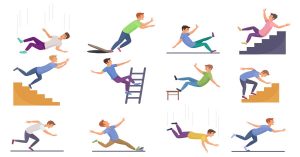
According to the National Institute on Aging, six out of 10 falls happen in our homes. Fortunately, indoor fall prevention tips are easy to implement with a bit of planning and forethought.
- Clean Up Clutter
- Widen Paths and Walk-Throughs
- Mind Your Cords
- Watch Out for Your Pets
- Check Your Rugs
- Improve Your Lighting
- Repair Any Tripping Hazards
- Clean Up Quickly
- Mind Your Footwear
- Step Carefully on Stairs
- Exercise
- Avoid Loose Clothing
- Get a Grip
- Good Vision is Vital
- Medication Matters
Removing tripping hazards may seem simple, but it’s the easiest way to prevent a fall. Piles of stuff, items on the stairs, hallways narrowed by belongings, and other clutter in your home all contribute to falls. Even too much clutter on a table can be an issue if the pile makes it hard to see that something has fallen on the floor or if a pile is so large it topples over.
A tight path around furniture, a narrow space between a sofa and coffee table, and laundry blocking the hallway can all contribute to falls. Even a footstool in the wrong place can be a hazard. Move items like magazine racks, plant stands, ottomans, and clothes away from high-traffic areas. Small changes to open up space for walking can improve safety.
Whether a light cord or extension cord, it can act as a tripwire. If it’s the cord for an item that stays in one place, tuck it out of the way. If that’s not feasible, use carpet tape or such to keep it in place and tight to the ground. When it comes to cords for items that don’t stay in one place, like charging cords for phones and tablets or a cord for a heating pad, get in the habit of being aware of where they are. Tuck them out of the way when possible, and use cords that are high contrast to the area in which you use them so they’re easier to spot.
You love them. They want to be with you. That means your dog or cat can easily turn into a tripping hazard. The CDC estimates that pets cause more than 86,000 injuries per year by causing falls. According to the CDC, people age 35 to 54 and those younger than 15 are especially prone to it. Though, anyone can be susceptible.
Dogs are more likely to cause a fall than cats, according to statistics. Obedience training can help prevent falls by making your dogs more responsive to commands. Pet toys and food or water dishes can also be falling hazards.
Throw rugs on tile or hardwood floors can slide and cause a fall. Install non-slip tape underneath or replace with rugs with rubber grips – or remove them all together. Carpet edging can also be an issue. Make sure they’re screwed down tight.
Having adequate lighting is essential to make sure you can see and avoid tripping hazards. In addition to boosting your general lighting, consider installing night lights, motion sensor lights, or strip lighting, especially in hallways, on paths, and on and around stairs. It’s equally important outdoors as it is indoors.
Repair loose wall-to-wall carpeting, floorboards that stick up, warped tiling, and other similar floor disturbances.
If anything is spilled on the floor, wipe it up quickly. Liquids can be a falling hazard – and so can be dried sticky residue. A fast clean up can keep you safe. This also applies to spills on a table that can drip over the side.
Slippers have caused a lot of falls. Make sure whatever you wear has good, slip-resistant treads. Shoes that fit securely because of laces or zippers are more secure than slip-ons. Non-slip socks with rubberized grips are usually safer than walking on bare feet.
Many people switch to living on one floor when they reach a certain age, whether that involves moving to a ranch-style house or rearranging their home. If you do have to use the stairs (it can be good exercise) make sure to use a stair rail, go slow, turn on the light, and consider installing slip-resistant treads.
Don’t groan at the suggestion. Maintaining your balance and stability through activities like yoga or tai chi can make a big difference. Maintaining a healthy weight can also help with balance and stability. Weight-bearing exercise can also help with improving bone strength. Staying active in general helps prevent falls.
Wide pants, flowing skirts, and baggy clothing can look cute and be comfortable, but the extra fabric can get caught and cause a fall. Having the right length pants is also important to avoid tripping.
Install handrails, stair rails, and hand grips where appropriate. It’s always better to have more than not enough.
Keep your eyeglass prescriptions up to date and have an eye exam regularly.
Always ask your doctor about side effects when they prescribe new medication. Also, be sure you know if it needs to be taken with water, food, or anything else because not following instructions can cause dizziness. Even medications you’ve taken for a long time can be an issue if they interact with a new one. Ask if anything you’re taking, individually or in combination, can affect your balance or cause dizziness.
Talk to Total Chiropractic Care and Wellness
Chiropractic care can help keep you stable, especially when combined with exercise. In the event of a fall, chiropractic care can help you get back to normal more quickly. Contact us at Total Chiropractic Care. You will receive a comprehensive evaluation to determine if it’s the right solution for your needs and when. Dr. Goldman creates treatment plans that incorporate pain management services as well as general lifestyle recommendations to help you live the best life you can. Contact us today.
